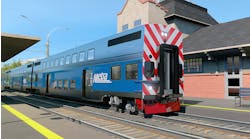Choosing the Ideal Rail Battery — Why Nickel-Cadmium Should be Top-of-Mind
Uninterruptible power is crucial for all types of applications. For the rail industry, operators depend on long life, onboard batteries designed with reliability, robustness and safety to ensure continual operation of emergency backup systems. Additionally, opportunities to eliminate sudden failure and enhance public safety, via signaling systems at places like level crossings for example, are critical for operators.
Emergency backup applications typically serve two specific purposes: one, to provide emergency power to critical operations which can include emergency braking and tilting systems; two, to deliver backup power for low-voltage onboard systems, including door operation, communication and control functions, ventilation and lighting. Furthermore, these onboard batteries can ensure engine starting, supplementary traction power and buffer functions. In a metro system, buffer functions facilitate immediate demands for power — like peaks for emergency braking — as well as to accommodate when there is a gap in the track or in electrified depots.
When analyzing needs for a rail battery, you should ask yourself a few questions:
- What is behind the trend of Nickel-Cadmium’s (Ni-Cd) prominence in the rail industry?
- How will we accomplish the ideal balance of reliability, lifetime costs and performance?
- What is a battery going to cost?
Ni-Cd Technology
Ni-Cd technology is the most resistant of mainstream technologies to sudden death. The rigid, steel structure of Ni-Cd supports sintered/PBE electrodes. This ensures a single cell will not break down in an open circuit and results in no corrosion of the steel plate structure. In addition to absence of unexpected sudden death, Ni-Cd gives an operator more control over the ageing of active materials — it is slow and predictable — and, there are no issues due to shedding of active material.
For example, high-energy SMRX-F3 battery systems provide backup power for services ensuring passenger safety and comfort, such as lighting, ventilation, door control, Wi-Fi and communication systems. It also assists with fail-safe train startup and its compact design enables further accommodation for passenger transport. Additionally, this battery system meets the designated requirements of OEMs and railway operators for instant diesel engine starting on locomotives and DMUs.
While considering batteries for your rail application, high-temperature operation, frequent cycling and tolerance to overcharge or over-discharge are more factors to evaluate. A Ni-Cd battery’s lifetime only declines 20 percent for every 50 degrees Fahrenheit increase.
When it comes to cold temperatures, battery designs can accommodate oversizing — to assure it delivers the required power — even when operating in freezing climates. Another advantage of Ni-Cd is its smaller derating factor at lower operating temperatures, thus requiring limited oversizing. Eliminating the need for much oversizing facilitates the design of a smaller cabinet, and in turn fewer batteries to maintain — all helping keep costs at a minimum.
Additionally, onboard batteries support engine starting in all conditions, providing a constant current to the starter motor. Typically, engines need to be started once a day. Upon commencement, the battery is linked to a charger and kept ‘floating’ to ensure full power is constantly accessible.
Today, operators are trending toward utilizing multiple start abilities, enabling engines to stop while on breaks throughout the day resulting in noise and gas emission reductions, as well as fuel savings.
Evaluating Costs
It goes without saying the cost of failure of a system usually far exceeds the cost of the actual system. While evaluating cost, it is important to consider the significant amount of time planned for the train to be in service — sometimes many decades — and the sequential lifetime cost/total cost of ownership. A lifecycle cost analysis is an effective way to evaluate the costs correlated with battery ownership over a specific duration — necessary to accurately assess the design life with the actual service life. All costs are considered, including but not limited to transportation, installation, purchasing and administrative, the battery itself and replacement if required, standard inspections, discharge testing and decommissioning/removal. The analysis also includes the cost of sudden battery failure — equally important to predictable costs.
Along with a reliable design and hardware, today’s digitally-driven society furthers the need for abundant connectivity and remote visibility. The C.O.M.M. Batt monitoring system answers the need for amplified online visibility of all assets. The real-time remote monitoring system for onboard Ni-Cd rail batteries enables maintenance performance as needed, lengthening the battery service life and keeps costs at a minimum. While collecting real-time operational data the information is processed, and advanced modeling algorithms deliver a detailed, cohesive look at the battery status — augmenting efficiency across the board.
Many factors demonstrate the reliability and effectiveness of Ni-Cd batteries for rail operations. And while it is tempting to consider the initial purchase cost as the priority, it is vital to evaluate the total cost of ownership, particularly for a system that can be in operation for several decades. It is important to remember no single battery is appropriate for all applications — reliability and performance must be carefully evaluated.
Pierre Prenleloup is the Saft Railway Market Manager for Saft Batteries and can be reached at +33 15 86 31 707.
Twitter: @Saft_batteries
LinkedIn: Saft Batteries



